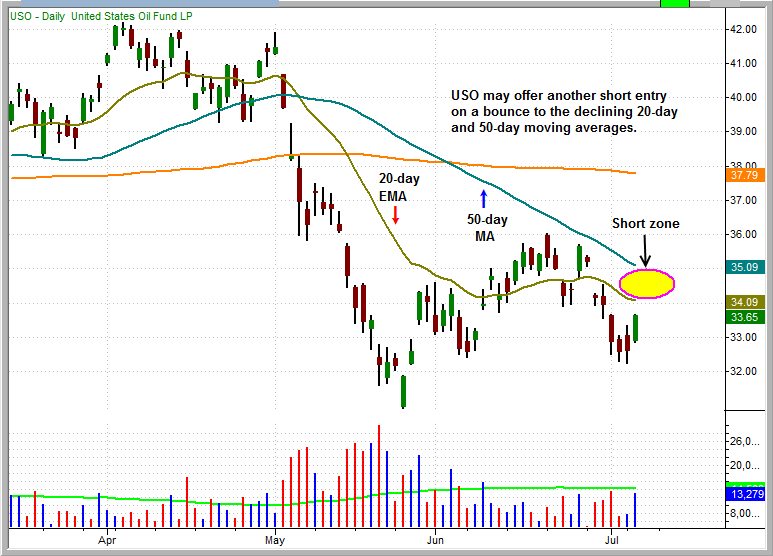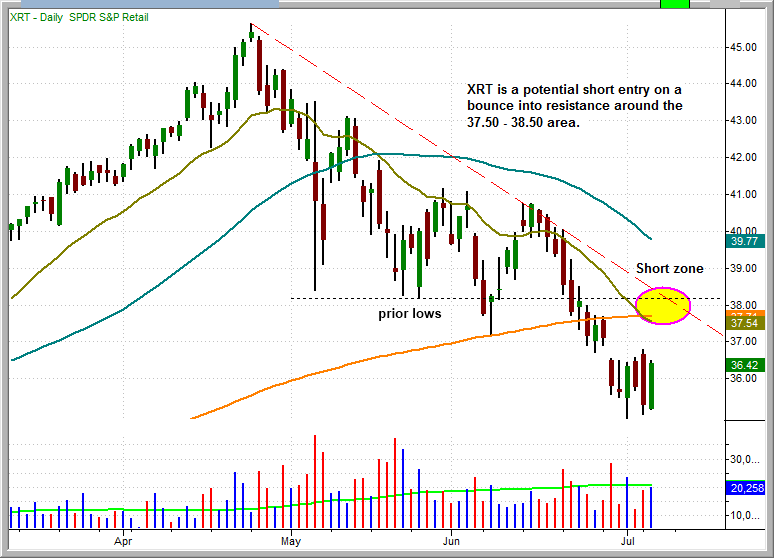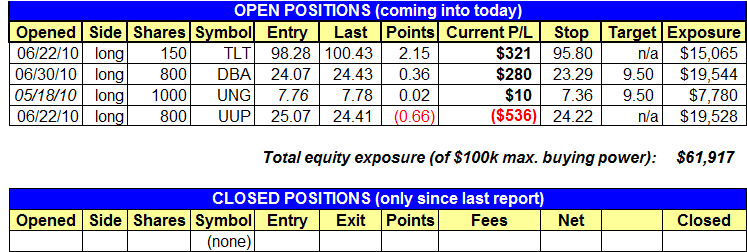Commentary:
After getting slammed for the past several weeks, stocks finally scored a substantial round of gains. The major indices opened near the flat line, but buyers immediately stepped in, propelling the broad market higher in the morning. This time, unlike all the other recent rally attempts, the bulls remained in control into the afternoon session, enabling stocks to hold on to all their intraday gains. Both the S&P 500 and Nasdaq Composite zoomed 3.1% higher, as the Dow Jones Industrial Average similarly climbed 2.8%. As they often do on strong rally days in the broad market, small and mid-cap stocks outperformed. The Russell 2000 and S&P Midcap 400 Index jumped 3.6% and 3.5% respectively. For the first time in three weeks, each of the main stock market indexes closed at its high of the day.
Unfortunately for the bulls, one key ingredient missing from yesterday’s rally was higher volume in both exchanges. In the NYSE, total volume edged just 1% above the previous day’s level, while volume in the Nasdaq eased 3%. Increased volume across the board would have been an encouraging sign of institutional accumulation, but mutual funds, hedge funds, and other institutions apparently took a rather passive role yesterday. Understandably, the “smart money” may be looking for more price confirmation before stepping in to start buying again. Nevertheless, market internals were quite strong. In the NYSE, advancing volume trounced declining volume by a margin of 17 to 1. Such broad-based buying equated to 95% of the stocks in the S&P 500 registering a gain yesterday. The Nasdaq adv/dec volume ratio was less positive, at just under 8 to 1,but still firmly bullish.
Last week, we covered our United States Oil Fund (USO) short position for a quick profit, in anticipation of a short-term bounce alongside of the broad market. The expected bounce came yesterday, as USO gained 3.1%. Now, yesterday’s strong reversal may spark a 2 to 5 day rally that would carry USO into significant resistance of its 50-day moving average, as well as its prior highs from June. As such, we view the $34.50 to $35.00 area as a low-risk short entry point, as the price action should not push much higher than the 50-day moving average, plus some wiggle room. The downside price target for this swing trade setup would be an “undercut” of the May 25 low, around $30.00. The setup is illustrated on the chart below:

SPDR S&P Retail (XRT) is another short setup we are monitoring for potential entry within the next few days. Take a look:

Since mid-May, XRT has been showing relative weakness to the broad market. When the major indices set slightly higher “swing highs” in mid-June, XRT set a “lower high.” Then, when stocks began selling off in the latter half of June, XRT again showed leadership to the downside. Now, there is a quite a bit of price resistance clustered in the $37.50 – $38.50 range. As such, a bounce into that area provides a low-risk short entry point. The 200-day MA and declining 20-day EMA provide the first line of defense, around $37.50. There is also resistance from the prior lows and the downtrend line, around $38.00. The 50% and 61.8% Fibo levels, measured from the high of June 15, to the low of July 1, are at the $37.80 to $38.60 area as well. If XRT makes another leg down after bouncing, an “undercut” of the December and January lows appears to be a decent target, around the $33.50 – $34.00 range. In addition to USO and XRT, we’re still stalking GDX for short entry, SRS (a “short ETF”) for buy entry, and VXZ for long entry. If any of these ETFs meet our entry criteria, we’ll promptly send subscribers an Intraday Trade Alert with details of entry.
In the July 6 issue of The Wagner Daily, we said, “As stocks have closed lower in nine of the past ten sessions, it’s quite reasonable to expect at least a very short-term bounce going into this week. However, in the intermediate-term, the major indices are actually poised for resumption of their downtrends that began in April.” With the main stock market indexes moving higher in the first two days of this holiday-shortened week, we are indeed seeing the bounce we anticipated. But when the main stock market indexes broke down below key levels of horizontal price support last week, an abundance of overhead supply was left behind in its wake.
Because the major indices will likely have great difficulty moving back above their 50-day moving averages in the near future, we primarily view this counter-trend bounce as merely an opportunity to initiate new short positions with a better reward-risk ratio (it is also a second chance to undisciplined investors and traders to unload any losing positions that were not sold when they should have been). Very short-term traders may consider buying iShares Russell 2000 (IWM), which would likely lead the broad market if there is more buying interest, but the time horizon for such a trade should not be a hold time of more than 2 to 5 days. Overall, until price and volume action of the broad market proves otherwise, the path of least resistance, at least in the intermediate-term, is down.
Correction: In our July 7 commentary, while discussing ProShares Ultrashort Real Estate (SRS), we said, “If VXZ attempts to breakout and fails. . .’ The ticker symbol should have read “SRS,” rather than “VXZ.” We apologize for any confusion.
Today’s Watchlist:

Market Vectors Gold Miners (GDX)
Short
Shares = 250
Trigger = $50.75 limit (bounce that probes just above the 50-day MA)
Stop = $53.30 (beyond 61.8% Fibonacci retracement from June 28 high to the July 1 low)
Target = $44.30 (“undercut” of major support from April lows)
Dividend Date = n/a
Notes = This setup, which we’ve been stalking for short entry since July 2, is now approaching our short entry point. Another decent gain in today’s session will cause it to trigger for short entry, right at resistance of both its 20 and 50-day moving averages. See the July 2 issue of The Wagner Daily for further explanation of this setup.
Be aware this ETF may be on your broker’s “hard to borrow” list, which means your brokerage firm’s web site may initially tell you that shares are not available for shorting. If this occurs, we recommend you phone your broker and specifically ask them to locate shares of this ETF to borrow for short selling. With a little push, your firm should easily be able to call around and get shares for you within a matter of minutes. If not, consider switching to a different firm who offers a wider selection of stocks and ETFs for shorting. Just a little tip for subscribers who run into this issue.
Daily Performance Report:
Below is an overview of all open positions, as well as a performance report on all positions that were closed only since the previous day’s newsletter. Net P/L figures are based on the $50,000 Wagner Daily model account size. Changes to open positions since the previous report are listed in red text below. Please review the Wagner Daily Subscriber Guide for important, automatic rules on trigger and stop prices.
- No changes to our open positions.
- On July 1, TLT paid a dividend of 0.31 per share. This additional profit has been added to both the “Points” and “Current P/L” columns (shaded in light blue to indicate dividend distribution included).
- Reminder to subscribers – Intraday Trade Alerts to your e-mail and/or mobile phone are normally only sent to indicate a CHANGE to the pre-market plan that is detailed in each morning’s Wagner Daily. We sometimes send a courtesy alert just to confirm action that was already detailed in the pre-market newsletter, but this is not always the case. If no alert is received to the contrary, one should always assume we’re honoring all stops and trigger prices listed in each morning’s Wagner Daily. But whenever CHANGES to the pre-market stops or trigger prices are necessary, alerts are sent on an AS-NEEDED basis. Just a reminder of the purpose of Intraday Trade Alerts.
- For those of you whose ISPs occasionally deliver your e-mail with a delay, make sure you’re signed up to receive our free text message alerts sent to your mobile phone. This provides a great way to have redundancy on all Intraday Trade Alerts. Send your request to [email protected] if not already set up for this value-added feature we provide to subscribers.

Having trouble seeing the position summary graphic above?
Click here to view it directly on your Internet browser instead.
Notes:
Edited by Deron Wagner,
MTG Founder and
Head Trader